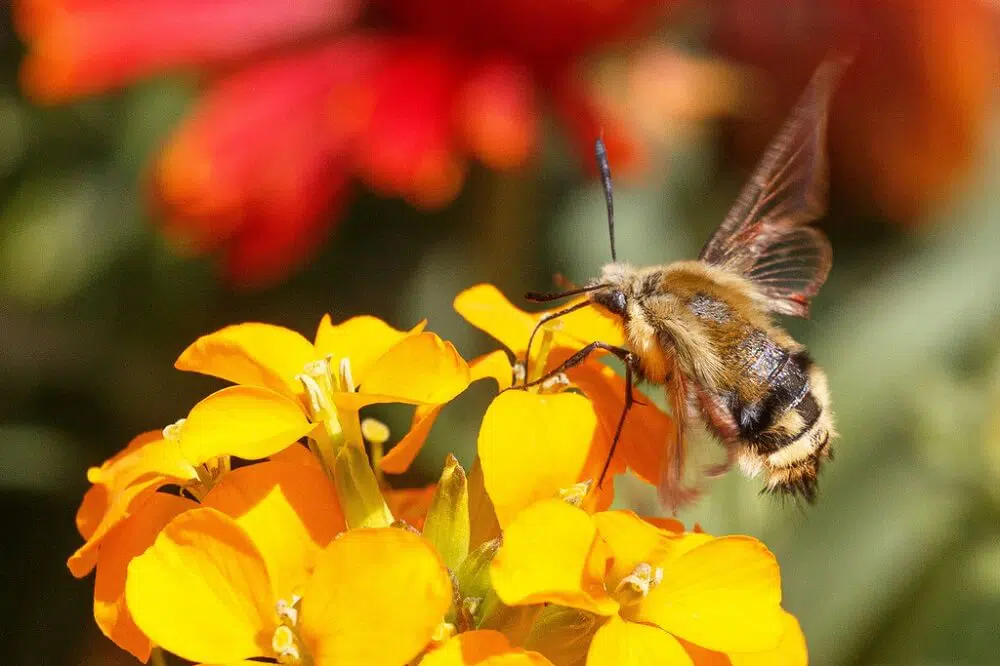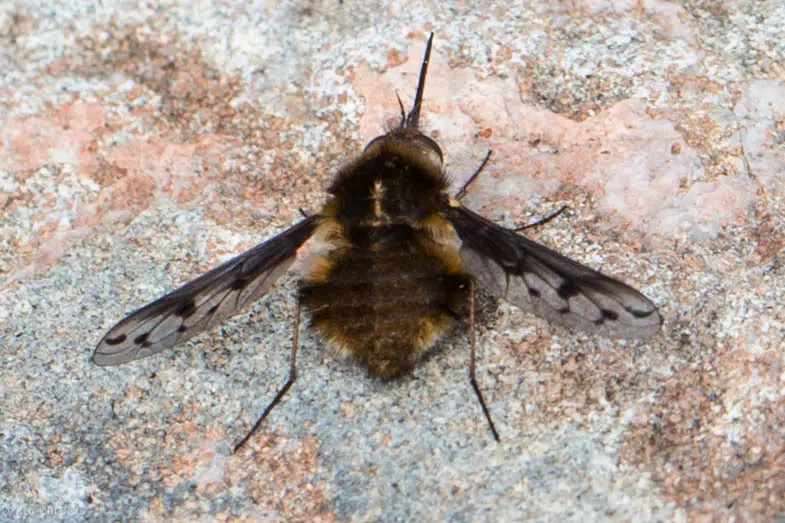There are 15 species of hummingbirds in the US. These are small colorful birds measuring between 3 and 5 inches in general.
Some bugs that look like hummingbirds resemble these characteristics of size and color. Many of them can even be confused with hummingbirds.
Here are the most common species of bugs that look like hummingbirds.
Table of Contents
1. Rocky Mountain Clearwing
As its name suggests, this moth (Hemaris thetis) is found across mountainous habitats and beyond. Part of the Sphingidae family, it’s a common species in some US states, mainly on the West Coast.
The moth species is known for hovering next to plants where they feed on nectar. This sometimes makes people assume they are hummingbirds.

Sizing differences compared to hummingbirds are small. Rocky Mountain Clearwing moths have a short wingspan between 30 and 50mm.
This species can come in multiple colors but these are generally variations of brown and olive green.
Most Rocky Mountain Clearwing moths are known for having a brown thorax. This thorax can sometimes be olive green.
The abdomen or the lower part of its body is either black or olive green. A distinct bright yellow band is seen along the abdomen both when the moth has a black abdomen and when it has an olive green abdomen.
Its wings are partially transparent, similar to the wings of hummingbirds.
Moths of the Rocky Mountain Clearwing genus have brown wing margins.
Known for being diurnal, this moth species is often confused with small hummingbirds.
Apart from the physical traits that make it similar to the small colorful birds, its flight characteristics further make it resemble hummingbirds.
Rocky Mountain Clearwing moths are known for being able to quickly change in-flight direction, which makes them as agile as hummingbirds.
2. White-headed Bee Fly

This species (Bombylius albicapillus) is known for preferring dry habitats where it feeds on wildflower nectar.
Small size and a short wingspan are some of the common reasons these flies are confused with hummingbirds.
They are known to have a short wide body of gray-brown coloring with a blonde tint.
Flies of the genus have the same thorax and abdomen coloring on their bristle-like hairs that cover the body.
They can be distinguished from other Bombyliidae flies by a fine blonde lien that runs from the middle of the thorax to the end of the abdomen.
The wings of the flies are partly black and partly transparent.
The white-Headed Bee Fly genus is known for its wide North American distribution.
Since they prefer drylands they are mostly seen in deserts of the US.
3. Hummingbird Clearwing

Both the physical traits and the behavior of Hummingbird Clearwing moths (Hemaris thysbe) make them resemble hummingbirds. The species is even confused with hummingbirds at times.
Coloring varies depending on its region (found in the Mid-West and on the Western Coast) but it’s generally a combination of colors.
The thorax is olive-green to brown. The abdomen is red with black parallel lines.
Both the olive green and the red colors are also seen on its wings. The underside of the moth is mostly white.
This is a migratory species of moth which means it has a wide habitat in the US. It always seeks fruits and honeysuckle for food.
Hummingbird Clearwing moths are mostly associated with hummingbirds for how they collect pollen and nectar from flowers. They have a long proboscis which helps them pierce through flowers easily.
This long proboscis is what makes some people confuse it with hummingbirds.
Otherwise, this diurnal species also has its habit that can make it easier to distinguish from other species.
For example, it only visits flowers in the afternoon when the weather is warmest. This can be prolonged into the evening on warm days.
The moth is neither beneficial nor seen as a pest. It doesn’t invade crops and it doesn’t have a major pollination role.
An exception applies to orchids, flowers this species is known to occasionally pollinate.
4. Snowberry Clearwing

Snowberry Clearwing (Hemaris diffinis) is known for having a golden or olive green color with a black band at the top of the abdomen.
The species is also known as the Flying lobster due to its shape and colors.
These moths resemble hummingbirds through their multi-colored body as well as through their transparent wings with black margins.
Some of these moths are also known to show hints of blue coloring on the abdomen as well as red undertones on their wings.
Sizing resembles medium-size and larger hummingbirds as Snowberry Clearwing has a wingspan of up to 2 inches.
These moths are seen all over the US. They are diurnal moths mostly interested in snowberry, honeysuckle, thistle, and nectar from other plants.
The easiest way to see this month is to find it in its natural habitat. It’s a prevalent species in Eastern US where it’s highly active during the day.
Snowberry Clearing moths are active in the afternoon. They will rest in the evening if they can’t find any good source of pollen, just like other moths of the Hemaris genus.
5. White-lined Sphinx

This moth species (Hyles lineata) is sometimes referred to as the Hummingbird moth. Its methods of collecting nectar make it resemble hummingbirds.
It flaps its wings rapidly as a means to maintain hover next to the flower it collects pollen from.
The species has been known for being both diurnal and nocturnal. It’s believed it prefers nocturnal feeding.
The White-lined Sphinx is confused with hummingbirds when it comes out to feed in the evening.
It’s one of the larger moths that resemble hummingbirds with a wingspan of over 3 inches.
The species gets its name from the 6 white lines that cross its brown body vertically.
Distinct physical traits also include triangular-shaped wings which support fast-flying patterns.
Sometimes these moths can be hard to see as their stripped bodies tend to blend them in with the visited flowers.
However, they are often seen around their larvae which are green with orange spots and easier to see.
6. Greater Bee Fly

Often mistaken with bumblebees, the Greater Bee Fly (Bombylius major) has similarities to hummingbirds as well. It’s known for fast wing flapping which is used for efficient hovering around flowers.
Also known for its long proboscis, this fly is among the species that are nectar robbers. They use the long proboscis to pierce flowers and such the nectar.
The fly is also known for sometimes eating pollen of wildflower bluets. Most studies show it doesn’t have a certain preference towards pollen, however.
Females have been found to consume significantly more pollen than males which also means they are easier to spot.
However, both males and females have a unique flight pattern which makes these flies stand out and to further association with hummingbirds.
The species is known to fly around a vertical axis in a mating flying pattern also known as yawing.
7. Hummingbird hawk-moth

These moths (Macroglossum stellatarum) are common in the Northern Hemisphere. They have gray coloring with a black banded abdomen.
Their wings are orange and relatively short compared to the size of the body. A maximum wingspan of 1.8 inches is characteristic of the species.
These moths are sometimes mistaken for hummingbirds due to their long proboscis.
This is a long mouthpiece that acts as a straw that pierces flowers and is then used to drink nectar.
Hummingbird hawk-moths are similar to hummingbirds as they don’t land on flowers to collect pollen.
Instead, they prefer to hover above or at the same height with the flower piercing it with the proboscis from a few inches away.
The species is also known for a few other distinct traits which make it efficient at collecting pollen.
For example, Hummingbird hawk-moths have excellent vision. This allows them to distinguish colors a bit easier than other moths.
Another unique trait allows these moths with very good vision to continue collecting pollen even when it rains. This is an ability most other moths don’t have.
Otherwise, it has a similar flight schedule from afternoon until early evening even if it has a good vision which allows it to continue feeding late into the evening whenever it finds abundant flowers such as those of the Galium family.
8. Nemestrinus rufipes
The brown and black Nemestrinus rufipes fly is often confused with hummingbirds. It hovers and it flaps its wings quickly like hummingbirds.
Its natural habitat is found in the warm climate of the Middle East and other parts of the world.
The species is often seen as one of the largest outside North America. However, little is known about it apart from its nectar-collecting preferences.
These flies are mostly seen around Bougainvillea flowers. These are vividly-colored ornamental bush flowers that attract this species the most. They are followed by wild radish in popularity.
Part of the Nemestrinus genus, the species is distinguished by a body with various shades of brown, gray, and black.
Its legs and wings are brown as well as its thorax. The abdomen is brown with black markings which can sometimes make people mistake the species for bumblebees as well.
Further Reading: